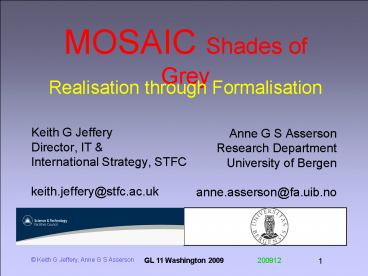Keith G Jeffery - PowerPoint PPT Presentation
1 / 14
Title:
Keith G Jeffery
Description:
Title: Relating Intellectual Property Products to the Corporate Context Created Date: 10/24/2004 10:27:58 AM Document presentation format: Diavoorstelling – PowerPoint PPT presentation
Number of Views:61
Avg rating:3.0/5.0
Title: Keith G Jeffery
1
MOSAIC Shades of Grey
Realisation through Formalisation
- Keith G Jeffery
- Director, IT
- International Strategy, STFC
- keith.jeffery_at_stfc.ac.uk
- Anne G S Asserson
- Research Department
- University of Bergen
- anne.asserson_at_fa.uib.no
2
Structure
- Background
- The Hypothesis
- Proposed Architecture
- Objects, Data and Metadata
- Requirements
- Architectural Solution
- Conclusion
3
Background Mosaic / Grey
- Designed
- For a purpose
- Formal structure
- To improve access and understanding
- Composed
- Of component pieces in structures
- Representation
- Of something in the human mind
- Communicate
- The idea to others
- Effort
- To produce the grey objects and to provide the
repository
4
Hypothesis
- A grey literature collection is much better
collected, structured, catalogued, utilised and
maintained within the context of a research
environment (commonly known as e-Research or
e-Science) - which relies on CERIF-CRIS to provide
- improved metadata for each GL object
- contextual research information
- access to other recorded research information
- thus improving the integration and publicising of
grey within the research scene. - The key is
- improved data collection,
- improved interoperation
- improved query relevance and recall
- all based on the formal syntax and declared
semantics of a CERIF-CRIS.
5
Objects, Data and Metadata
- Conventional metadata in Grey repositories is
insufficiently formal resulting in much end-user
effort in - Input
- browsing for retrieval
- interoperation
- If metadata has formal syntax and declared
semantics - Improved ease of data input
- Ensuring quality of data
- Providing automated retrieval with improved
recall relevance - Reliable automated interoperation
6
Requirements
- Input of grey object and its metadata
- Pre-filling
- Workflow (bite-sized chunks)
- validation
- Retrieval of set of grey objects meeting criteria
- Recall
- Relevance
- Homogeneous access over heterogeneous sources
- Subsequent processing
- Count, sum, average ? graphics, modelling
- Relating to other information
- To provide the end-user with the complete picture
7
Architectural Solution (1)
- same canonical schema
- formal syntax and declared semantics
- data for some purposes, metadata for others
- linking relations between entities with
date/.time stamp and role such that - the structure is articulated flexibly,
- new entities can be added and related
- links to external systems can be made
- using the same framework
8
Architectural Solution (2)
- the above provide an optimal base framework for
the processing required including - input within a progressive workflow,
- retrieval and reporting,
- subsequent processing including statistical and
graphical reports - interlinking to other systems both within and
outside of the research organisation.
9
CERIF
Funding Programme
Classification
CERIF EU Recommendation to Member States
10
Result PublicationInstance Diagram
OrgUnit M
Part of
member
Person A
OrgUnit O
employee
member
OrgUnit N
Part of
Project leader
Project P
author
owns IPR
Metadata in CERIF-CRIS much richer than usual
repository
Publication X
11
CERIF- CRIS Repositories at 1 institution
12
.and multiple institutions
13
Conclusion (1)
- The mosaic of grey literature is not yet revealed
easily. - Its complex patterns representing structures,
and the beauty of the complete form are not
recognised. - This is because of
- the heterogeneity of the sources,
- the lack of a canonical schema either fo
- storage/query/results management
- interoperation over heterogeneous systems.
- Worse, existing sources use metadata schemas that
- do not have sufficiently formal syntax
- lack declared semantics
- both of which can be rectified by the use of
CERIF.
14
Conclusion (2)
- The take-home message is clear use CERIF as the
canonical schema for grey literature. - to accommodate legacy systems use a CERIF
wrapper. - This would mean that
- 1. query and retrieval provide better relevance
and recall - 2. data input quality is improved
- 3. systems can interoperate, to provide the
end-user with a homogeneous view over
heterogeneous distributed systems - 4. statistical and graphical processing can be
reliable - 5. interoperation with other systems within and
outwith the research organisation is facilitated.































